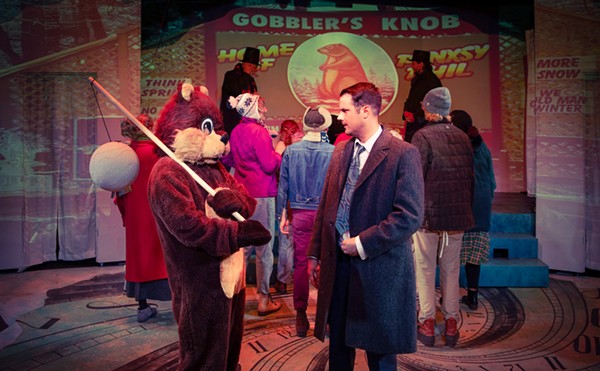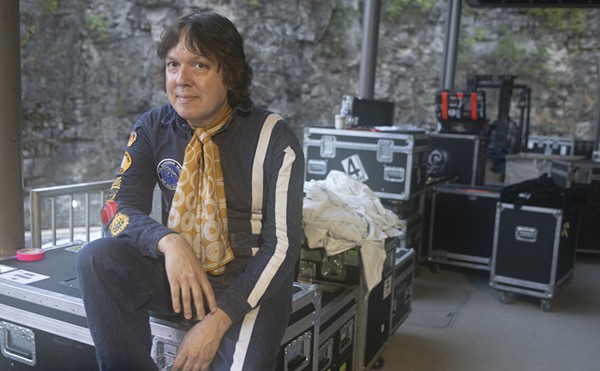For most of us, though, factory-made products serve a useful purpose: Soda-pop cans and milk jugs, for example, come in uniform sizes, so we know they'll fit into their proper places in the fridge. Cleveland artist Royden Watson goes so far as to celebrate this form of standardization by creating his own take on aluminum cans and plastic jugs.
Royden Watson, American Standard, at the Cleveland Center for Contemporary Art, is an eclectic collection of everyday stuff, some of it recycled and some of it newly fashioned. The show has a primarily intellectual appeal, because it encourages thought about ordinary things. It teaches more than it delights.
Watson named the show in reference to the urinal that Marcel Duchamp wanted to place in the groundbreaking 1917 exhibit of avant-garde art in Paris. Watson expands on Duchamp's idea that viewer familiarity causes blindness to everyday things (for instance, have you noticed the label on your toilet recently? Many such fixtures were made by American Standard). Watson argues that these ubiquitous objects have unique qualities worth taking time to appreciate.
There are no plumbing fixtures in his show, but assembly-line products abound, notably in "Refreshing Beverage," which consists of 18 plain, silver-hued soda cans mounted on tiny platforms on the wall. Each 12-ounce can sits in front of an aluminum panel painted to match the colors traditionally associated with the brand, such as green for Mountain Dew or red for Coke. Watson polished off the identifying marks on a dozen real cans and then created another six from cast aluminum. Both batches are supposed to look identical, but they don't. The factory-made cans have smoother rims.
Gallon milk jugs, four in all, preside over pedestals in a center area. These 21- to 23-pound beauties of polished stone could easily break your foot if you dropped one on it. From a distance, especially if you are near-sighted, they do signal "milk." The one of alabaster, with its cracked interior, especially resembles curdled milk forgotten in the refrigerator.
Trickier are the "Portraits of Studs," re-creations of those ubiquitous sawn planks that frame most houses. Perfect in dimension and color, they mimic the real thing so exactly that visitors to the opening show thought they were left there by workmen. Each plank's pattern is individual; only the brush strokes prove they are fakes.
In "Main Street of America," Watson takes a different tack regarding standardization -- this time involving a common street address. He made rubbings of "123 Broadway" in eight different U.S. cities, including Cleveland. The best of the lot is "Los Angeles," which has an impression from a big GTE manhole on it. Other than that, these 48-by-48-inch graphite and paper works are tedious in their similarity, even if the artist may have risked his life lying down in the street to get some of them.
The show's most compelling and beautiful piece is a reference to Frank Lloyd Wright's concept of a "Usonian Standard" -- cheap, practical, efficient houses Wright touted for the average family. Watson has made his own version, which he calls "Watsonian with Hearth." It's a 96-by-96-by-96-inch structure of oak that looks like an open-sided box with an open roof. Inside on a pedestal rests a vase holding the romantic standard: a dozen red roses with baby's breath. Watson says it's a tribute to his wife, Arlene, the heart of his home. This piece is the one truly lovely work in the show. Although it's composed of standard components, it rises beautifully above being a mere curiosity in its salute to what really makes a house a home: love.
It's less certain that the other works in the show justify the effort Watson takes to make his point: that if we embrace mass-produced creations, we might learn to appreciate them. Watson's lively mind and craftsmanship do enable him to highlight factory-made goods and to turn consumerism into food for thought. And yet, one leaves the exhibit worrying more about the value of an artist's time. Was it best spent duplicating the specks on a piece of wood, when all one need do is go to a lumberyard? One also leaves glad that Michelangelo decided to carve the marvelous David instead of a Renaissance milk jug and hopes, now that Watson has proved his point, he will move on.













